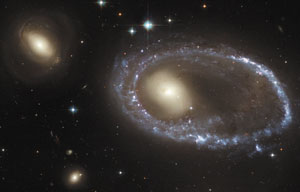
Observations with the Very Large Telescope Interferometer (VLTI) at the ESO Paranal Observatory in Chile are for the first time providing a clear picture of the immediate surroundings of the black hole at the centre of an active galaxy. They reveal the gas and dust torus that obscures the heart of the galaxy NGC 1068.
NGC 1068, also known as Messier 77, is located in the constellation Cetus (The Whale) at a distance of about 50 million light-years. It looks like an ordinary barred spiral galaxy, except that its centre is unusually bright. NGC 1068 was among a group of 12 galaxies identified by Carl Seyfert in 1943 as having a nucleus with a spectrum showing peculiar emission lines from highly ionized atoms. These so-called Seyfert galaxies can be thought of as low-luminosity quasars, as was proposed shortly after the discovery, in 1963, of the first quasi-stellar radio source (quasar).
The active nucleus of Seyfert galaxies and quasars emits radiation over the whole electromagnetic spectrum, from radio to X-rays and even gamma rays. The central engine at the origin of this activity is now known to be a supermassive black hole with a mass up to thousands of millions of times that of the Sun. The black hole is believed to be fed from a tightly wound accretion disc of gas and dust that encircles it. The compressed and heated matter spinning near the black hole at close to the speed of light is thought to give rise to the enormous luminosity of active galactic nuclei. Outside this disc matter is believed to form a toroidal (doughnut shaped) cloud of gas and dust, which absorbs the ultraviolet light from the central disc and emits infrared radiation. The observed characteristics of a given active galaxy would thus depend on whether this torus is blocking our view of the nucleus.
Infrared interferometry has now revealed for the first time the presence of such a torus in NGC 1068. The torus, heated to a temperature of about 50 °C, is found to be 11 light-years across and 7 light-years thick, with an inner, hotter zone (500 °C) about 2 light-years wide. Identifying such small regions at the distance of NGC 1068 corresponds to seeing a pin-head at a distance of 25 km. The necessary angular resolution of about 0.01 arcsec is achieved by combining the light from two 8.2 m telescopes in the VLTI separated by up to 200 m and using the mid-infrared interferometric instrument (MIDI), which is sensitive to light at a wavelength near 10 µm. The MIDI spectra of NGC 1068 also provide information about the possible composition of the dust grains. The most likely constituent is calcium aluminium-silicate (Ca2Al2SiO7), a high-temperature species also found in the outer atmospheres of some super-giant stars.
These very first observations of an extragalactic object by the technique of long-baseline interferometry in the mid-infrared region open the way to a completely new field of astronomy: the study of gas and dust structures surrounding and feeding the heaviest black holes in the universe.
Further reading
W Jaffe et al. 2004 Nature 429 47-49.
Picture of the month

This image of a beautiful ring of blue star clusters bigger than the size of our Milky Way galaxy was released to commemorate the 14th anniversary of Hubble’s launch on 24 April 1990. This ring galaxy, known as AM 0644-741, lies 300 million light-years away in the southern constellation Dorado. It was once a normal spiral galaxy, before being crossed at its centre by a smaller galaxy. While the yellowish nucleus of stars was only mildly affected by the collision, the gas rushing outwards has formed a ring, like ripples in a pond after a rock has been thrown in. The compression of the gas in the ring triggers the intense star formation outlined by many blue star clusters, which contain massive, young and hot stars. (Credit: NASA/ESA/Hubble Heritage Team.)








